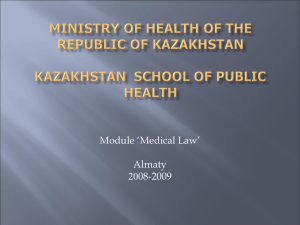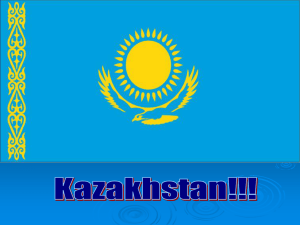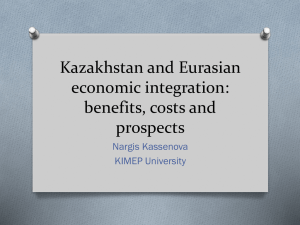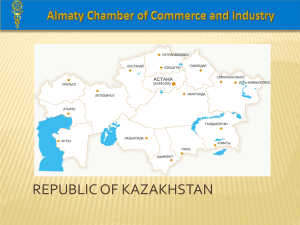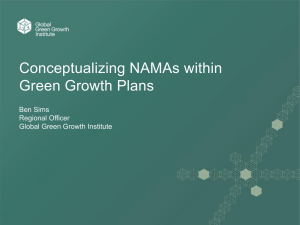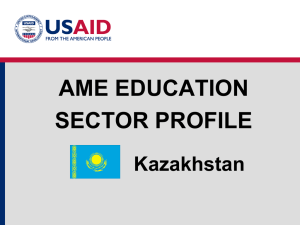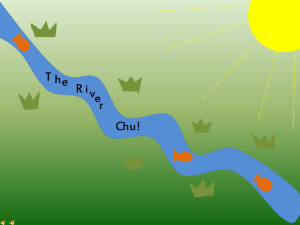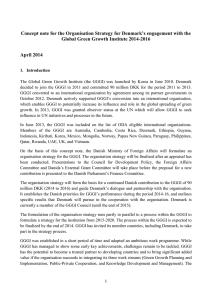SELECTION, SET UP AND SCOPING PP1
advertisement
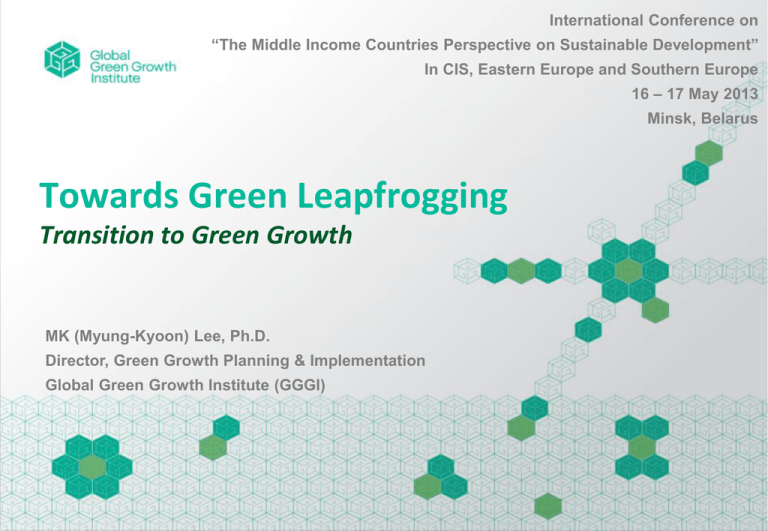
International Conference on “The Middle Income Countries Perspective on Sustainable Development” In CIS, Eastern Europe and Southern Europe 16 – 17 May 2013 Minsk, Belarus Towards Green Leapfrogging Transition to Green Growth MK (Myung-Kyoon) Lee, Ph.D. Director, Green Growth Planning & Implementation Global Green Growth Institute (GGGI) Table of Contents Brief Introduction to GGGI What is Green Growth and Why Case Study 1: Korea Case Study 2: Kazakhstan Brief Introduction to GGGI 2 GGGI’s Vision and Missions Vision Missions A world-class international organization dedicated to promoting and disseminating green growth worldwide, grounded upon partnerships between developing and developed countries 1. Mobilizes world-class technical support and builds local capacity for the design and implementation of green growth strategies 2. Provides an international knowledge-sharing platform for developing countries, evidence-based learning and policy innovation 3. Deepening cooperation among developed, developing and emerging economies and practitioners and scholars 3 Moving forward and fast “GGGI will significantly contribute to a variety of UN’s activities regarding climate change” - UN Secretary General Ban Ki Moon Conversion into an International Organization, 18 founding member states The Creation of GGGI announced by President Lee Myung-Bak at the UNFCCC COP-15 GGGI is launched at the East Asia Climate Forum Copenhagen, Denmark December 2009 Seoul, Korea June 2010 Rio, Brazil June 2012 Seoul, Korea Oct. 23 2012 4 Core Businesses Working with partner governments and organizations. GG Planning & Implementation (Capacity Building & Knowledge Sharing) Public-Private Partnership Partner Gov./GGGI Research 5 Key Principles and Delivery Model GGGI’s role A trusted neutral partner, helping to explore GG opportunities, particularly in developing countries A platform for gathering different resources and technical capabilities for the purpose of serving developing country governments, not an agent of any individual or group of donors Key principles when conducting its work Begin based on the country’s current growth and development aspirations and plans Develop rigorous analyses which will become a base for the GG plans and strategies designed Train and develop country counterparts’ capacity throughout the analytical process Engage actively with relevant inter-ministerial and inter-agency members and stakeholders Delivery model for GGPI With the adoption of GG plan, GGGI deploys a team of experts to work with those responsible for implementation of the plan Team up with three available sets of human resources: local government counterparts critical to sustainability and long-term impact of the project; staff of GGGI providing significant analytical skills and sectoral expertise; external consultants complementary to GGGI’s capacity 6 What is GG and why? 7 Global Risks 2011 8 Global Challenges: Need a New Paradigm New constraints & challenges Resource constraints: depleting natural resources, diminishing space per capita Deepening economic & social inequality Climate Change: unprecedented, highly uncertain Degraded Earth’s carrying capacity: food & water security, biodiversity loss, deforestation, ocean and soil acidification A changing globalized world Accelerating increase in demand for resources by connecting the world real time Aggravating frustration and anger of the poor Social, political, economic instability increase 9 Global Challenges: Need a New Paradigm Need a new development paradigm to simultaneously address economic, environmental and social challenges under new constraints Economic performance Environmental sustainability Social inclusiveness Urgent, strong, collective efforts required Decisive and strong action is urgent Delay means greater risks and higher costs for human development, economies and the environment Collective actions of the global community required 10 What is Green Growth? Economic Growth Green Job Creation Green Innovation & Technology Green Growth Climate Resilience Social Justice Environmental Sustainability Energy Access & Security Global Green Growth Institute : “green growth is the new revolutionary development paradigm that sustains economic growth while at the same time ensuring climatic and environmental sustainability. It focuses on addressing the root causes of these challenges while ensuring the creation of the necessary channels for resource distribution and access to basic commodities for the impoverished (social inclusiveness). Under this new paradigm, new ideas, transformational innovations and state-of-the art technologies will become the major drivers for growth” OECD : “Green growth means fostering economic growth and development, while ensuring that natural assets continue to provide the resources and environmental services on which our well-being relies. To do this, it must catalyze investment and innovation which will underpin sustained growth and give rise to new economic opportunities.” UNEP : “A green economy is one that results in improved human well-being and social equity, while significantly reducing environmental risks and ecological scarcities. It is low carbon, resource efficient, and socially inclusive. In a green economy, growth in income and employment should be driven by public and private investments that reduce carbon emissions and pollution, enhance energy and resource efficiency, and prevent the loss of biodiversity and ecosystem services.” 11 Paradigm shift Addressing the global challenges requires a comprehensive rethinking of our ways of valuing and measuring socioeconomic progress and ecosystem services. A new paradigm should recognize inherent value of environmental protection and social justice in enabling economic growth. Rethinking of Growth Paradigm: Quantity-oriented (labor, capital) : more input for more output Quality-oriented (new ideas, innovation) : less input but more output Broadening the concept of “Going Green”: Responding to Environmental Degradation, Climate Change Enhancing added value while promoting resource efficiency and social inclusiveness 12 The same goal, but different development path C B A Kim Hoseok (2012), GGGI 13 13 Green Growth Green Growth Is concerned with integrating environmental security and resource efficiency considerations at the heart of country’s economic development planning and implementation Accepts a country’s growth targets as a given rather than trying to adapt or subordinate them to a particular environmental agenda Analyzes the policy options that could yield significant co-benefits for growth and environmental protection and resource security within the economy or within its significant sectors Is a practical attempt through economic policy to operationlize the normative frameworks represented by the sustainable development Seeks to fuse sustainable development’s three pillars into a single intellectual and policy planning process, thereby recasting the very essence of the development model so that it is capable of realizing sustained economic growth while safeguarding or improving the environment. 14 Case Study 1: Korea’s Transition to Green Growth 15 The Green Leap Forward Past 60 Years (from 1948) Next 60 Years (from 2008) Economic Growth Green Growth Quantitative (traditional, fossil fueldriven) Qualitative (low-carbon, sustainable development) Factor-intensive (labor & capital) Innovation-based (new ideas) More input more output Less input more output High dependency on foreign energy sources Energy self-sufficiency (renewable sources) Aid recipient Aid donor Miracle on the Han River Miracle on the Korean Peninsula A History of Miracles A New Dream 16 Why embrace a new development paradigm? ECONOMIC SLOWDOWN CLIMATE CHANGE ENERGYIMPORT DEPENDENCY Economic Growth Social Justice + Environmental Sustainability Green Technology By around 2100, an increase in the average temperature by 4˚C in Korea will inflict more than US$45.5 billion of cumulative economic damage. A sea level rise of 80 cm will submerge 605 km2 of area (larger than Seoul) and the flood in 11 coastal cities will affect more than 370,000 victims. If daily average temperature reaches 28.1˚C or above, there will be 11 additional mortalities per day in Seoul; a temperature increase of 4˚C will reduce rice yield by 15% in rural areas. Green Job Creation Energy Security Climate Resilience 17 Green Growth in Motion: The Korean Experience LEGAL & INSTITUTIONAL FRAMEWORK NATIONAL Framework Act on Low Carbon, Green Growth Presidential Committee on Green Growth (PCGG) National Strategy for Green Growth & its Five-Year Plan 2009-2013 REGIONAL INT’L East Asia Climate Partnership (EACP) Global Green Growth Institute (GGGI) Korea’s Five-Year Green Growth Plan (2009-2013) Green Growth Strategy VISION 3 Objectives Green Growth Plan for Implementation VISION 10 Policy Directions Actions Climate resilience & energy independence Diversification of energy sources and enhancing energy security 5th Green Power by 2050 7th Green Power by 2020 Strengthening climate adaptation capacity Development of green technologies Creating new growth engines for sustainable growth The “greening” of existing industries and promotion of green industries Advancement of industrial structure Engineering a structural basis for the green economy Improving quality of life & enhancing international standing Greening the land, water and building the green transportation infrastructure Bringing green revolution into our daily lives Becoming a role model for the international community as a green growth leader IMPLEMENTATION (based on yearly action plan, 2009-2013) Efficient GHG emissions reduction Investment Plan Major Expected Output USD 5.1 bn Publication of carbon information USD 13.5 bn Energy intensity (toe/USD 1,000) USD 32.7 bn Increase in water resource (100,000 m3) USD 10.2 bn World’s market share of green technology products (%) USD 4.1 bn GHG reduction of industrial complex (1,000 tons) USD 9.8 bn Export of broadcasting& communication Industry (USD 100,000) USD 1.6 bn Domestic carbon market size (bn USD) USD 22.8 bn Public transportation use rate (%) USD 1.7 bn Green procurement amount (bn USD) USD 0.6 bn Green ODA (%) Fiscal & Financial Incentives Stirring the Green Market through Financial Inducements Creating an Enabling Environment for Green Growth 20 Challenges Ahead Sustaining the momentum • This requires strong political leadership with clear vision • Transition of power must not impede green growth initiatives Providing the proper incentives • Restructure the domestic market and energy system • Introduction of carbon taxes has been opposed by top conglomerate firms (However, the Emissions Trading System or ETS has been passed in May 2012) Playing the global standards game • Standards are critical in emerging industries such as smart grid • Korea has to influence standard-setting process in the international arena despite its small domestic market Strengthening public-private collaboration • The government has successfully collaborated with the private sector in the past • Reforming the carbon and electricity pricing systems will challenge this relationship 21 Korea’s Performance in Green Growth 1. Environmental & Resource Productivity Subject Emission Energy Material Water Indicators 2. Natural Asset Base Trend GDP/GHG emission Improving, but stagnant in 2009 GDP/Primary energy consumption Improving, but stagnant in 2009-2010 Share of Renewable energy Improving, but short of target rate Domestic Material Consumption/GDP Improving Municipal waste per capita Insufficient, but improved in 2009 Chemical fertilizer/ arable land Improving: improved greatly post-2008 Municipal water per capita Improving, but stagnant in 2010 Environmentallyinduced health problem Access to sewage treatment & drinking water Indicators Trend Population exposure to urban air population Improving: improved greatly post-2008 Urban green space per capita Improving Population connected to sewage treatment Improving Population with access to safe drinking water Subject Water Indicators Trend Rainfall per capita Stagnant Area of forest Decreasing Timber stock Increasing Biodiversity Share of threatened wildlife Improving Fish Share of aquaculture Increasing Forest 4. Policy Response & Economic Opportunities 3. Environmental Quality of Life Subject (based on OECD Green Growth Indicators) Improving Subject Indicators Green R&D Government green R&D expenditure Increasing: increased greatly post-2008 International patent applications Increasing Environmental industry Environmental sector employment Decreasing, but began increasing since 2008 Green Finance Share of green ODA Increasing Share of environmentally-related tax Decreasing, but increased in 2010 Environmental protection expenditure Increasing Green technology Environmentallyrelated tax & recovery cost Trend 22 Korea’s Performance in Green Growth Korea at the green growth crossroads Korea has decided to change course from high-energy, import dependence to lowcarbon green growth Korea has moved from No. 15 in terms of climate-smart exports in 2005 to No. 7 in 2010, and expect to displace Japan as No. 4 in 2015 The green strategy will survive beyond 2012 through innovation Source: Korea at the green growth crossroads: Themes that will sustain beyond 2012, HSBC Global Research, March 16 2012 23 Case Study 2: Kazakhstan National Green Growth Plan (KNGGP) 24 Introduction KNGGP Funding Kazakhstan National Green Growth Plan (KNGGP) including: Subtask 1: Water Supply and Wastewater Management Development Program Subtask 2: Kazakhstan National Sustainable Energy Plan • European Bank for Reconstruction and Development (EBRD) • 1.45 million euros • Comprehensive national green growth plan based on analysis of Kazakhstan’s green growth potential (KNGGP has been rebranded as “Input for Intended Key Project Output a Strategy for Kazakhstan’s Transition to Green Economy”) • Establishment of a water sector development program focused on future private sector participation in PPP scheme • Development of national level energy plans focused on renewable energy, energy efficiency, and housing modernization Overall Project Outcome • Framework for an inclusive green growth plan for Kazakhstan at the national level • An environment where a national level green growth strategy can be adopted and implemented by the government and all stakeholders Alignment to GGGI’s Mission • Advances the theory and practice of green growth by developing a practical case study of formulating national green growth plan • Facilitates public-private cooperation and mobilize private resources to foster an enabling environment for resource-efficient investment 25 KNGGP Overview The KNGGP aimed to promote, support, and develop a comprehensive national green growth plan for Kazakhstan that is adequate for the country and will be implemented by the Government. Rebranded as “Input for a Strategy for Kazakhstan’s Transition to Green Economy” in order to support the Green Economy Strategy of the Kazakhstan government. Umbrella project Kazakhstan National Green Growth Plan Recommendations on national level strategy establishment for GG ( “Input for a Strategy for Kazakhstan’s transition to Green Economy”) Sub-task 1 Water Water Supply and Waste Water Management Development Program in Kazakhstan Analysis of current condition of Kazakhstan water sector Case studies on international water sector reform Suggestions on institutional and legislative reform for PPP Promotion Feasibility study for a water PPP project Development of concrete recommendations and an action plan for water sector development Energy Sub-task 2 Guidance on critical elements for establishing National Energy Efficiency Strategy Guide to the development of a Kazakhstan renewable energy action plan Support plan on modernization and development of housing Guidance on critical elements for establishing a Master Plan for Water Resource Management in Kazakhstan 26 Kazakhstan’s Development Challenges Kazakhstan’s macroeconomic performance is the strongest in Central Asia but the oil-rich country faces imbalances in longer-term economic development. Reducing excessive dependency on primary industries and commodity exports, mainly oil & gas National oil reserve of 39.8 billion barrels (2010), the country’s major revenue generator, is estimated to last for only 63 years. BASIC FACTS Official name Addressing lack of capacity and institutional structure, especially in the water and energy sectors Has significant gaps in energy and infrastructure sector, esp. on appropriate policies, markets and institutional frameworks to allow efficient development of those sectors. Capital Astana Official language Kazakh and Russian Type of government dominant-party, unitary presidential state Leadership (Pres.) Protecting its fragile ecology (semi-desert geography) from the adverse impacts of climate change Kazakhstan has been identified as one of the countries with high vulnerability and low adaptation potential for climate change effects. Republic of Kazakhstan Nursultan Nazarbayev GDP (2011) $186 billion (total) $11,167 (per capita) Population 16,911,900 (Jan. 1, 2013 est.) Major Industries crude oil, base metals, chemicals, food , agriculture 27 Kazakhstan’s Long-term National Vision Kazakhstan, which is strategically located between Asia and Europe, has shown its commitment to green growth. Green Economy Strategy to be announced 2030 2020 2013 National Strategy Strategic Plan 2020 (6 key themes including economic diversification) Kazakhstan 2030 (7 long-term priorities) In 2010, a national report on the Integration of Green Growth Tools in the Republic of Kazakhstan was presented at the 3rd Astana Economic Forum and at the Sixth Ministerial Conference on Environment and Development in Asia and the Pacific (MCED-6), Astana. Astana Green Bridge Initiative (AGBI), a brainchild of the president of Republic of Kazakhstan, was announced in 2011 to promote green investment and green technologies bridging Europe and AsiaPacific. In accordance with the letter of the Ministry of Environment Protection, the Government of Kazakhstan invited GGGI and EBRD to support the government’s efforts to initiate the KNGGP. This puts Kazakhstan as the first in Commonwealth of Independent States (CIS) to announce a transition to green economy and foster green policy, technology, and investments in the region. 28 KNGGP Analytical Approach Procedure Analysis of Green Growth Trend Analysis of Green Growth Trend Review of Kazakhstan's Green Growth Potential Review of Analysis Kazakhstan's Green &Industrial Recommendation Growth Potential Economic Impact Analysis Output Kazakhstan Macro economy Economic Trend - Global Trend - Regional Trend Environmental Trend - Climate Change - Energy Crisis SWOT Analysis Necessity of Green Growth Analysis of National Plan and Programs - Purpose - Current Policies - Result of Analysis Industrial Analysis Economic - Kazakhstan’s Impact Industrial Analysis for Structure and its introducing Current State carbon - Input-Output charges Analysis - KEI Env- Priority Sector Linkage Model Analysis Recommendation for Kazakhstan’s Green Growth Establishment of KNGGP and Recommendation for Green Growth Green Growth for Kazakhstan - Vision - KNGGP - Milestone Strategic Policy Directions for Green Growth - Greening Existing Assets - Promoting New Growth Engine through Industry Restructuring - Building the Foundation for Sustainable Growth 29 Recommended National Level Strategic Framework for Green Growth in Kazakhstan Be Green Kazakhstan beyond the expected Top Green Nation in Central Asia Strategic Direction Greening Existing Asset Promoting New Growth Engine through Industry Restructuring Building the Foundation for Sustainable Green Growth Policy Direction Enhance energy efficiency Forge national water mgmt. system • Diversify energy source • Introduce IWRM • Effective management of national energy efficiency (Upgrade energy infrastructure, establish EEI, VA & Energy Audit) • Clear R&R for water mgmt. btw ministries • Green transportation Strategic reform in industry structure • Select and concentrate on core industries for green growth • Green virtuous cycle • New eco-friendly materials and devices for building and infra • Shift to value added green industry Create green education and job • Green education • Green employmen t Mitigation of GHG emission • Pollution mgmt. system • GHG inventory system Fiscal support • Green finance for green technology and industry • Green tax Institutional and legislative reform • Green organization and governance • Green M&E system • Green Legislation • PPP promotion 30 Lessons Learned Key Lessons Learned 1. Strong Political Leadership Decisive resolution for transformational changes & reforms in institution, incentive systems, organization, etc. Power to coordinate various views and different interests 2. Active Government Intervention (Top-down) Share Vision and set clear mid-to-long term goals Build strong legal & institutional frameworks to support policy implementation Introduce consistent policies and regulatory schemes to spur real changes Maximize the power and influence of the market Provide incentives to engage the private sector Make consultation and coordination efforts for relevant stakeholders 32 Key Lessons Learned (contd.) 3. Active Participation from the Public (Bottom-up) Increase public awareness on green growth Devise action-oriented policies to induce public participation Take active measures to lead behavioral changes of people Disseminate the idea & practice of green growth to local communities and rural areas to engage the entire nation 4. Mobilizing Global and Local Partnership Take into account trans-boundary effects of global challenges Mobilize resources from various partners overseas Share Knowledge with neighbors as well as global leaders 33
